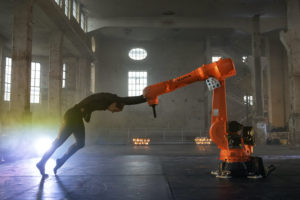Ballet Augsburg’s kinesphere: In a robotic dimension - Vancouver Ballet Society
- Home
- Features 2020 - 2023
- Ballet Augsburg’s kinesphere: In a robotic dimension

By Jeannette Andersen
Augsburg Theater is one of the smaller regional theatres in Germany — and right now its ballet company is one of the most innovative. Spurred on by past lockdowns due to COVID-19, the company’s introduction to digital forms, including virtual reality, was speeded up. Last season, Ballet Augsburg created two ballets filmed with a 360-degree camera, with the necessary VR viewing goggles sent to the homes of ticket buyers, who were allowed to keep them for two days. [These VR works were previously reviewed in DI.] The theatre opened this season on September 10 with a third VR ballet, kinesphere, by Ballet Augsburg’s director and chief choreographer Ricardo Fernando.

The Brazilian-born former dancer, who has been with Ballet Augsburg since 2017, tends to create work set in a fascinating world of colourful imagination, as with his last piece for the stage, Winterreise, which featured dancers fancifully costumed as trees and animals. Winterreise premiered online during the lockdown in October 2020, but will be onstage in the current season.
Kinesphere is also highly fanciful, with its theme of man and machine explored through a love story between KUKA KR Iontec 30R2100 — an industrial robot weighing over a thousand pounds — and the scientist, weary of her fellow humans, who builds it. The robot fights with her colleagues (performed by an ensemble of 16), and the scientist ends up alone with KUKA. Principal dancer Gabriela Zorzete Finardi, as the scientist, is strong and expressive, moving with a litheness that somehow makes the angular movements of KUKA look gentle and emotional.
At the time of writing, the film was in post-production, but snippets released online are mind-boggling. In one, Finardi nestles up to KUKA, sliding her leg over its long orange arm and caressing it lovingly. Her movement is sensual and erotic, but more surprising is KUKA’s seemingly very human response. KUKA stretches up its long foldable arm and bends it gently over Finardi in a tender, curious and probing way.
When I recently spoke with Fernando on the phone, he explained how different it was to choreograph for a robot, which does not give any feedback; it just does what you tell it. That the animation of KUKA works so effectively is partly due to composer Lilijan Waworka’s very emotional and evocative music, with a soft piano tune that meanders around the sound of the orchestra like a voice whispering secret words of love. When Fernando commissioned the soundtrack, he asked Waworka to make music full of love.

Bursting with energy and filling his sentences with laughter, Fernando talked with a contagious enthusiasm about kinesphere. Working with a 360-degree camera, he said, is very different from choreographing for the stage, where you only have to concentrate on what the piece looks like from the auditorium. VR technology opens up a new dimension of space: viewers are not fixed to their chairs, but may even find themselves hovering high above the dancers. In boléro, the VR piece he created last season, computer technology made it possible to transform his 18 dancers into a cast of hundreds. Fernando would love to offer some of these technical “tricks,” as he calls them, onstage.
Working with an industrial robot added another layer of complication. First Fernando animated a robot in a computer program, which went to a technician who programmed KUKA, the actual robot, using a joystick and a computer. Then Fernando started choreographing with the dancers.

The VR film experience for audiences is very different, too. Virtual reality technology can create the illusion that the viewer is sitting in a three-dimensional space among the dancers and, similar to a stage performance, is able to decide what to look at, maybe all the dancers or perhaps just a foot sliding over the floor. There is an intimacy that is not possible onstage: suddenly a dancer can be standing right in front of you, seeming to look into your eyes.
Kinesphere was filmed in an old industrial hall in martini-Park, a two-minute walk from the theatre, which is under restoration. For the premiere, at the martini-Park theatre, three consecutive groups of 20 were led into the orchestra’s rehearsal space and seated on revolving stools, where they saw the performance wearing VR goggles.
The film will be available online throughout the season. At the moment goggles are only sent to Germany, Switzerland and Austria, but if you have your own, you can buy tickets to the performance here.
Upcoming, Augsburg Theater ventures further into the digital future. This season it received a state grant for a new project, the Digital Hub. This will be an online platform in which audiences and artists can meet and interact in VR surroundings, and it is going to be accessible from all over the world.

